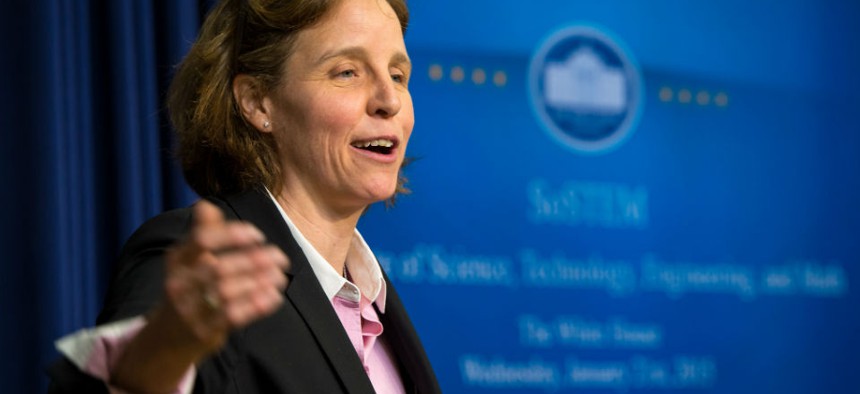How to Innovate in a Short Timeframe and on a Shoestring Budget

United States Chief Technology Officer Megan Smith speaks during the annual White House State of Science, Technology, Engineering, and Math address on Jan. 21, 2015. (NASA/Bill Ingalls)
The Igniting Innovation showcase and awards emphasized one resounding point: Federal innovation does not have to be an oxymoron.
More stringent fraud detection at the Social Security Administration thanks to a Web service that can efficiently sift through terabytes of data.
Standardized HR for the Agriculture Department, which cut the four-month hiring process in half.
Migrating NASA’s information to the cloud, thus increasing collaboration while decreasing operations and maintenance costs by 25 percent.
These were only a few of the many ground-breaking federal projects showcased Feb. 5 as part of the second annual ACT-IAC Igniting Innovation showcase and awards. Although none of them snagged first place, they all helped to emphasize one resounding point: Federal innovation does not have to be an oxymoron.
Altogether, there were 30 projects showcased at the Ronald Reagan Building in Washington, D.C., which were chosen from a pool of more than 100 candidates. While some were federal agency specific, others were tied to local government and private industry.
The afternoon began with an introduction to these state-of-the-art projects. Crowds of industry folk milled around the maze of booths equipped with PowerPoint presentations and colorful poster boards, posing questions to the project representatives.
Once the attendees had a thorough understanding of the project offerings, they were asked to use the event-specific mobile app to help determine the eight finalists.
As keynote speaker, federal Chief Technology Officer Megan Smith highlighted the importance of this type of event in which innovative tools and creative ideas can be shared.
As an example, Smith cited the National Cancer Institute’s SmokeFree.gov initiative, which uses text messages to help people quit smoking. Now that code for this and other projects have been released, “we don't have to repay for these things; we can pay for the optimization, the upgrade, extra features, specialty things that we need for each city," she said.
Smokefree.gov was among the eight finalists who -- in "Shark Tank" fashion -- got the opportunity to present their project in five-minute, lightning-round sessions. Four industry-knowledgeable panelists then gave their own opinion in a rapid-fire sound bite.
Another finalist was General Services Administration’s Open Data in Motion. It showcased the many changes made to Data.gov over the last five years, including automation and its move to open source technology.
The last finalist called was the Department of Homeland Security’s Management Cube, which collects data from eight of its management systems so employees can have full access.
“What I want to emphasize is that innovation is a whole lot of hard work,” said Stacy Marcott, deputy chief financial officer for DHS, during her project’s showcase.
Although this was likely true across the board, Andy Robinson, Innovation Institute chair, drew a slightly different conclusion from the projects presented.
“They’re able to address some very serious problems without a whole lot of money and a short period of time,” he said in an interview with Nextgov. “A lot of these innovations were delivered in under 12 months.”
Perhaps the biggest surprise of the afternoon came with the announcement of the winner, who was not among the many federal agency innovations or even a private industry project.
The grand prize was presented to the New York City Department of Transportation’s NYCStreets Permit Management System, which oversees the process in a 24/7 digital fashion.
But the local government win did not seem to surprise Robinson. “Innovation is the great equalizer,” he said. “You don’t need hundreds of millions of dollars to pull off innovation."
NEXT STORY: What Kind of Federal CIO Will Tony Scott Be?


